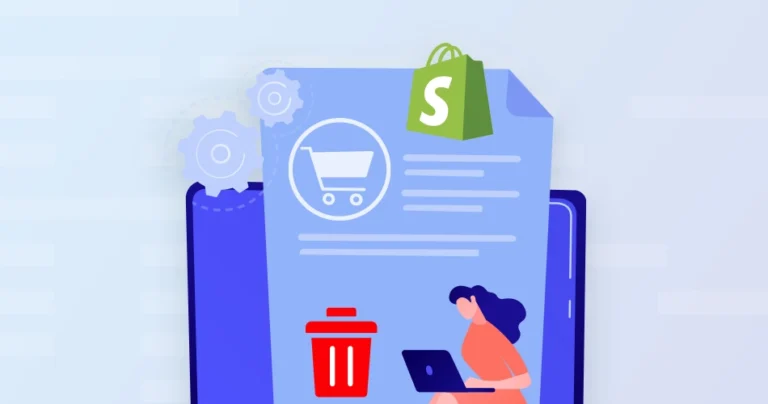Imagine a customer cancels their order minutes after it’s placed, but the fulfillment process has already begun. Or perhaps you’ve accidentally created duplicate fulfillment orders. These scenarios, while frustrating, are common for Shopify store owners.
Knowing how to efficiently delete fulfillment orders in Shopify is crucial for maintaining accurate inventory, streamlining operations, and ensuring a positive customer experience.
So through this blog, we’ll explain how the Shopify experts delete fulfillment orders by integrating an API, and how you can do it via the admin. Let’s begin.
What are Fulfillment Orders?
A fulfillment order is essentially a request sent to a specific location to fulfill the items listed in an order. Think of it as a detailed instruction sheet that outlines exactly what needs to be packed and shipped, including the items, their quantities, and the destination where they need to be sent.
How Fulfillment Orders Work
When a customer places an order on your Shopify store, a fulfillment order is automatically generated. This order contains all the necessary information to ensure that the right items are picked, packed, and shipped to the correct address.
Here’s a breakdown of what a fulfillment order typically includes:
- Items to be Fulfilled: A list of all the products that need to be shipped.
- Quantity: The number of each item that needs to be sent.
- Destination: The address where the items need to be delivered.
Why Fulfillment Orders Matter
Fulfillment orders play a pivotal role in the order management process. They help streamline operations by providing clear instructions to your fulfillment team or third-party logistics providers. This ensures that orders are processed accurately and efficiently, reducing the chances of errors and delays.
One of the key advantages of using Shopify is the automation it brings to the fulfillment process. Fulfillment orders are created automatically, which means you don’t have to manually generate these instructions. This saves time and reduces the risk of human error, allowing you to focus on other aspects of your business.
Why Delete Fulfillment Orders?
Managing an online store involves a multitude of tasks, and sometimes, part of that management includes deleting fulfillment orders. While it might seem counterintuitive to remove something that’s meant to help you track and complete orders, there are several valid reasons why you might need to do so.
Let’s explore some of these scenarios to understand better why deleting fulfillment orders can be necessary.
Order Cancellations
A fulfillment order is typically deleted when a customer cancels their order due to a change of mind, duplicate order, or error. Deleting the fulfillment order prevents shipping and ensures accurate inventory management, avoiding stock discrepancies.
Fulfillment Errors
Mistakes in fulfillment, such as wrong items, incorrect quantities, or address errors, can happen. Deleting the incorrect fulfillment order allows for corrections and ensures accurate fulfillment, maintaining customer satisfaction and efficiency.
Inventory Management
Accurate inventory management is essential for e-commerce success. Deleting a fulfillment order helps align records with stock levels, preventing overselling when an item is unexpectedly out of stock.
Changes in Order Details
Customers may request order changes, making the original fulfillment order invalid. Deleting it allows for a new, updated order, ensuring accuracy and enhancing the customer experience.
Operational Adjustments
Operational changes, like switching fulfillment partners or processes, may require deleting fulfillment orders. This ensures a smooth transition and maintains operational consistency.
Deleting fulfillment orders is an essential part of managing your online store effectively. No matter the reason, knowing when and how to delete fulfillment orders can help you maintain accuracy, efficiency, and customer satisfaction.
If you need help with deleting the fulfillment orders and ensuring the benefits, having help from our leading Shopify development company would be the best.
Deleting Fulfillment Orders via Shopify Admin
Shopify provides a straightforward way to delete fulfillment orders through the admin interface. Follow these steps:
Step 1: Log in to Shopify Admin: Go to your Shopify admin dashboard and log in with your credentials.
Step 2: Navigate to Orders: In the left-hand menu, click on “Orders” to view the list of orders.
Step 3: Select the Order: Find the order for which you want to delete the fulfillment. Click on the order number to open the order details.
Step 4: View Fulfillment: In the order details page, scroll down to the “Fulfillment” section. Here, you will see the fulfillment orders associated with the order.
Step 5: Delete Fulfillment: Click on the fulfillment order you want to delete. In the fulfillment details page, you will see an option to “Delete fulfillment.” Click on this option and confirm the deletion.
This process is a key part of ensuring that your fulfillment orders are accurately managed, helping you maintain inventory accuracy and customer satisfaction.
Deleting Fulfillment Orders via Shopify API
For those who prefer a more automated or programmatic approach to managing their Shopify store, the Shopify API offers a powerful way to handle fulfillment orders. Many developers also use the Get All Orders Endpoint API in Shopify to retrieve and manage order data before processing deletions. Whether you’re a developer or a store owner with technical skills, using the API can streamline your workflow and provide greater control over your fulfillment process.
Let’s dive into the steps required to delete a fulfillment order using the Shopify API.
Step 1: Authenticate
Before you can interact with the Shopify API, you need to authenticate your requests. Ensure you have the necessary API credentials and permissions. This typically involves generating an access token from your Shopify admin dashboard.
Step 2: Identify the Fulfillment Order
To delete a fulfillment order, you first need to identify it. Use the Shopify API to retrieve a list of fulfillment orders. You can do this by making a GET request to the following endpoint:
GET /admin/api/2023-10/fulfillment_orders.json
This will return a list of fulfillment orders, including their IDs, which you will need for the deletion process.
Step 3: Delete the Fulfillment Order
Once you have the fulfillment order ID, you can delete it by making a DELETE request to the following endpoint:
DELETE /admin/api/2023-10/fulfillment_orders/{fulfillment_order_id}.json
Replace {fulfillment_order_id} with the actual ID of the fulfillment order you want to delete.
Step 4: Handle the Response
After sending the DELETE request, the API will return a response indicating whether the fulfillment order was successfully deleted. Make sure to handle any errors or exceptions that may occur during this process.
If you prefer expert assistance, you can hire Shopify developers who specialize in API-based store management to handle these tasks for you.
Example API Request
Here’s a practical example of how you can delete a fulfillment order using cURL, a command-line tool for making HTTP requests:
curl -X DELETE "https://{your-store-name}.myshopify.com/admin/api/2023-10/fulfillment_orders/{fulfillment_order_id}.json"
-H "X-Shopify-Access-Token: {your-access-token}"
Replace {your-store-name}, {fulfillment_order_id}, and {your-access-token} with your actual store name, fulfillment order ID, and access token, respectively.
Using the Shopify API to delete fulfillment orders provides a flexible and automated way to manage your store’s operations.
Best Practices for Deleting Fulfillment Orders
Deleting fulfillment orders is a necessary task in managing your Shopify store, but it’s important to approach it with care to avoid any unintended consequences. Whether you’re using the admin interface or the API, following best practices can help ensure that your operations run smoothly and your data remains accurate. Let’s explore some key guidelines to keep in mind.
Backup Your Data
Before deleting any fulfillment orders, it’s crucial to backup your data. This ensures that you have a record of all orders and fulfillment details in case you need to refer back to them. Regular backups are a good habit to maintain for overall data integrity.
Test in a Sandbox Environment
If you’re using the Shopify API or making significant changes, it’s a good idea to test your actions in a sandbox environment first. This allows you to see the effects of deleting fulfillment orders without impacting your live store. It’s a safe way to ensure that your processes work as intended.
Document Changes
Keep a detailed record of any fulfillment orders you delete. Documenting these changes helps with auditing and ensures that you have a clear trail of actions taken. This can be particularly useful if you need to troubleshoot issues or provide reports.
Communicate with Your Team
If you’re part of a team managing the Shopify store, make sure to communicate any deletions with your colleagues. Clear communication helps avoid confusion and ensures that everyone is on the same page regarding order management.
Review and Confirm
Always review the details of the fulfillment order before deleting it. Double-check that you’re deleting the correct order and that there are no dependencies or pending actions that might be affected. Confirming the deletion ensures that you’re making an informed decision.
Monitor Inventory Levels
Deleting fulfillment orders can impact your inventory levels. Make sure to monitor your inventory closely after deletions to ensure that stock levels are accurate. This helps prevent overselling and ensures that your inventory management remains efficient.
Following best practices when deleting fulfillment orders can help you maintain the integrity of your Shopify store’s operations.
Let’s Conclude
Managing fulfillment orders is a critical aspect of running a successful Shopify store. Whether you’re handling order cancellations, correcting errors, or adjusting inventory, knowing how to delete fulfillment orders efficiently is essential.
Remember, deleting fulfillment orders should be done with care. Always backup your data, test in a sandbox environment, document changes, communicate with your team, review and confirm deletions, and monitor inventory levels.
Understand that prevention is always better than cure. So implement robust order management practices and double check the details before fulfillment. If you need help with the fulfillment process, have a consultation with us today!
FAQs On Shopify Delete Fulfillment Order
Q1. Why would I need to delete a fulfillment order?
You might need to delete a fulfillment order due to order cancellations, fulfillment errors, inventory adjustments, changes in order details, or operational adjustments. Deleting a fulfillment order ensures that your inventory and order management remain accurate.
Q2. Can I delete multiple fulfillment orders at once through the admin interface?
The Shopify admin interface does not support bulk deletion of fulfillment orders. You will need to delete each fulfillment order individually.
Q3. What tools can I use to make API requests to Shopify?
You can use tools like cURL, Postman, or any programming language that supports HTTP requests (e.g., Python, JavaScript) to make API requests to Shopify.
Q4. How can I prevent errors when deleting fulfillment orders?
To prevent errors when deleting fulfillment orders, always review the details of the order before deleting it, confirm the deletion, and follow best practices such as backing up data and testing in a sandbox environment.





